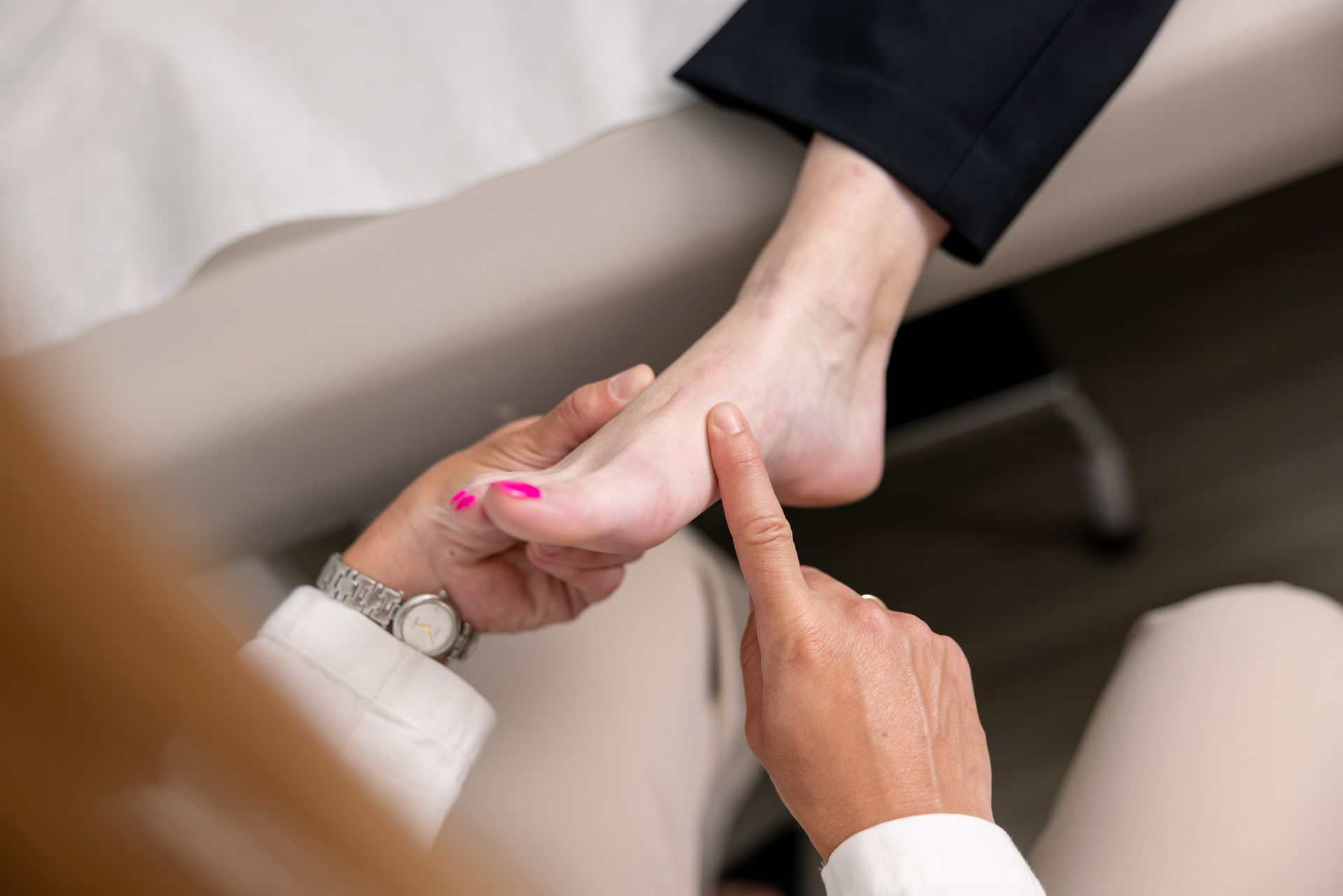Plantar Fasciitis
The Ultimate Guide to Understanding and Managing Plantar Fasciitis
RELATED PAGES
Plantar fasciitis is a common foot injury and one of the most frequent causes of heel pain, affecting millions of people worldwide. It occurs when the plantar fascia, a thick band of tissue connecting the heel bone to the toes, becomes inflamed. Early diagnosis and treatment are essential to alleviate pain and prevent the condition from worsening. This page provides a comprehensive overview of plantar fasciitis, its causes, symptoms, and management strategies, empowering those who suffer from heel pain to take control of their health.
What is plantar fasciitis?
Understanding plantar fasciitis starts with knowing what it is and how it affects the foot. The plantar fascia is a strong, fibrous tissue that supports the arch of the foot. It acts as a shock absorber, distributing pressure across the foot during movement. Plantar fasciitis is characterized by inflammation of the plantar fascia, often resulting from repetitive strain. This condition leads to microtears in the tissue, causing pain and discomfort, especially in the heel area.
What are Some Common Causes and Risk Factors of Plantar Fasciitis?
Plantar fasciitis can develop due to a combination of factors that place excessive strain on the plantar fascia. Overuse from activities such as running or prolonged standing is a common cause, as is foot structure, with conditions like flat feet, high arches, or abnormal walking patterns contributing to increased stress. Tight muscles, particularly in the calves or Achilles tendons, can also exacerbate the problem. Additional risk factors include obesity, wearing improper footwear, or making sudden changes in activity levels, all of which can significantly impact foot health and lead to the onset of this painful condition.
What are the Symptoms of Plantar Fasciitis?
Identifying the symptoms of plantar fasciitis is crucial for early intervention. The primary symptoms include intense heel pain that is particularly noticeable during the first steps in the morning. Additionally, individuals may experience stiffness and tenderness along the bottom of the foot.

What are the Differences Between Plantar Fasciitis and Other Heel Conditions?
Conditions such as heel spurs and Achilles tendinopathy can often present symptoms similar to those of plantar fasciitis, leading to confusion in diagnosis. Heel spurs are bony growths that develop on the underside of the heel bone, and while they may cause localized pain, they often coexist with or result from plantar fasciitis. On the other hand, Achilles tendinopathy involves degeneration of the Achilles tendon, which can lead to discomfort at the back of the heel that may be misinterpreted as plantar fasciitis pain. It's crucial to accurately differentiate between these conditions because each requires a specific treatment approach.
When Should I See Dr. Neumann for Plantar Fasciitis?
Consult Dr. Julie Neumann if pain persists for more than a few weeks or interferes with daily activities. By obtaining a proper diagnosis through a thorough assessment you can ensure you receive the most effective treatment tailored to your specific condition. This not only helps in relieving pain but also reduces the risk of further complications and promotes a speedy recovery.
"Plantar fasciitis affects more than 2 million people in the United States each year, and about 1 in 10 people will experience it at some point in their lives."
How is Plantar Fasciitis Diagnosed?
Accurate diagnosis is essential for effective treatment. While self-assessment can help recognize symptoms, professional evaluation is key to ensuring precise treatment. Diagnosing plantar fasciitis typically begins with a detailed patient history and a physical examination.
During the exam, Dr. Neumann may check for tenderness along the sole of the foot and evaluate the range of motion in the foot and ankle. She may also assess structural factors, such as high arches or flat feet, which can contribute to the condition.
In some instances, imaging tests like X-rays or MRIs may be recommended to rule out other issues, such as fractures. Once the diagnosis is confirmed, a tailored treatment plan can be created. This may include rest, ice therapy, stretching exercises, weight loss, orthotics, or physical therapy to relieve pain and promote recovery.
What are Non-Surgical Treatment Options for Plantar Fasciitis?
Non-surgical treatments are the first approach for managing plantar fasciitis. Lifestyle modifications play a key role, including rest to avoid activities that worsen symptoms and the use of supportive footwear or orthotics. Stretching exercises targeting the calf and plantar fascia, ice therapy to reduce inflammation, and gentle massage techniques on the arch of the foot can also provide relief.
For more advanced care, medical treatments may be recommended. Physical therapy can offer tailored exercises to enhance flexibility and strength, while nonsteroidal anti-inflammatory drugs (NSAIDs) help manage pain. Night splints can keep the foot in a stretched position overnight to alleviate discomfort. In some cases, extracorporeal shockwave therapy (ESWT) may be used, employing sound waves to stimulate healing in the affected area.
Are There Surgical Treatment Options for Plantar Fasciitis?
When conservative treatments prove ineffective, surgical options may be considered as a last resort. Surgery is typically reserved for cases where non-surgical interventions have failed to provide relief after at least 12 months of consistent effort. Two surgical procedures can be performed to address plantar fasciitis.
The first is plantar fascia release, which involves partially cutting the fascia to alleviate tension and reduce pain. The second is gastrocsoleus release, performed if you have a gastrocsoleus contracture that is thought to be contributing to the refractory plantar fasciitis. These procedures are usually tailored to the patient's specific condition, with the goal of improving mobility and reducing pain when other methods have not succeeded.
What are Some Prevention Tips for Plantar Fasciitis?
Preventing plantar fasciitis involves proactive measures to reduce strain on the feet.
- Maintain a healthy weight to reduce pressure on the feet.
- Wear supportive footwear with proper arch support.
- Incorporate regular stretching and strengthening exercises into your routine.
- Avoid overuse by gradually increasing activity levels.

How do I Manage a Chronic Case of Plantar Fasciitis?
Living with chronic plantar fasciitis requires a proactive approach to management and a commitment to overall well-being. Combining lifestyle changes with consistent treatment can help minimize symptoms and improve quality of life. Managing the emotional and mental health challenges associated with chronic pain is equally important, as persistent discomfort can take a significant toll. Seeking support from healthcare providers, therapists, or support groups can provide valuable coping strategies and emotional relief. Additionally, hearing stories from others who have navigated similar journeys can offer motivation, practical insights, and a sense of connection, making the path to recovery feel more achievable.
FAQs About Plantar Fasciitis
Can Plantar Fasciitis Heal on Its Own?
Yes, most cases can resolve with rest and home care, but persistent or severe symptoms require professional intervention.
Is Plantar Fasciitis Permanent?
No, with proper treatment, most people recover fully.
How Long Does Recovery Take?
Recovery varies but typically ranges from a few weeks to several months, depending on the severity of the condition and adherence to treatment. Most patients experience significant pain relief within a 9 to 12 month period.
Can Plantar Fasciitis Come Back After Treatment?
While many people experience full recovery, plantar fasciitis can recur if proper care is not maintained. Continuing to follow preventive measures and maintaining good foot health is key to avoiding relapse.
For more personalized care and expert advice, schedule an appointment with Dr. Julie Neumann. Together, we can develop a treatment plan tailored to your needs and help you get back on your feet.
Testimonials From Baton Rouge Foot & Ankle Injury PATIENTS
This is a paragraph. Writing in paragraphs lets visitors find what they are looking for quickly and easily.
This is a paragraph. Writing in paragraphs lets visitors find what they are looking for quickly and easily.
This is a paragraph. Writing in paragraphs lets visitors find what they are looking for quickly and easily.
This is a paragraph. Writing in paragraphs lets visitors find what they are looking for quickly and easily.
I had a fractured foot (which went misdiagnosed for six weeks prior to my appointment with Dr. Neumann) and then more recently plantar fasciitis. She diagnosed each issue, and explained what needed to be done for the best outcome. She is kind and compassionate, yet professional and very knowledgeable.
Joan Love, HealthGrades
After my ankle injury wasn't getting any better, I found Dr. Neumann. The entire staff was very welcoming and caring during my visits. Dr. Neumann is amazing! She not only treats you like she's known you a while, but she really breaks things down for you to understand and offers the best ways for your path to healing.
Jana Adams, Google
This was my first time visiting the Bone and Joint Clinic due to a foot and ankle injury. Dr. Neumann was friendly, attentive, and thorough in examining my symptoms and the root cause behind them. I left the appointment feeling confident in my treatment and recovery plan. I would absolutely recommend!
Quinn Rodney, Google
All Rights Reserved | Dr. Julie Neumann




